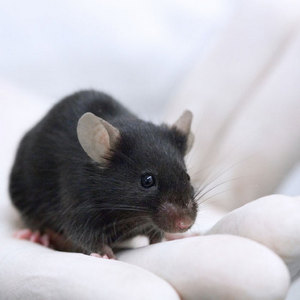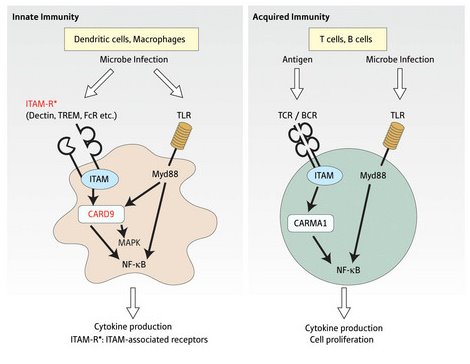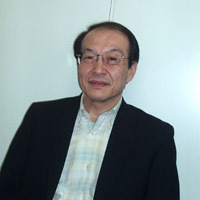Nov. 2, 2007 Research Highlight Biology
Signaling simplified
Japanese immunologists find differential usage of essential components of signal pathways in innate and acquired immune responses
 Figure 1: The function of the adaptor proteins CARD9 and CARMA1 in innate and acquired immune responses was studied in mice deficient in these proteins.
Figure 1: The function of the adaptor proteins CARD9 and CARMA1 in innate and acquired immune responses was studied in mice deficient in these proteins.
Threats to our health from attacking microbes are combated by the immune system; an intricate web of molecules that detect invasion, communicate emergency messages and activate the defense reaction. Immunity is vital to life, but when the system breaks down, debilitating conditions such as autoimmune disease and inflammatory illnesses can result. For all of these reasons, it is of particular interest that immunologists deconstruct the immune system and lay bare its component parts so that its mechanisms can be better understood and future therapies developed.
Now a team of researchers, led by Takashi Saito from the RIKEN Research Center for Allergy and Immunology in Yokohama, has given clear insights into the way constituent parts of the immune system communicate with each other. In their study recently published in Nature Immunology 1, the team describes a key factor through which urgent chemical messages are routed when the immune response is triggered.
Types of immune response
 Figure 2: Activation of immune cells through ITAM-receptors. Receptors on the surface of lymphocytes induce signal transduction pathways resulting in the production of cytokines.
Figure 2: Activation of immune cells through ITAM-receptors. Receptors on the surface of lymphocytes induce signal transduction pathways resulting in the production of cytokines.
The body mounts an immune response when invading pathogens are recognized by a variety of receptors found on the surface of white blood cells, namely myeloid and lymphoid cells. Each cell type is involved in one of two lines of defense against infection: innate and acquired immunity. The innate immune system is our first barrier against invading microbes; it recognizes and responds to pathogens in a generic way. The acquired immune system acts as a second barrier, and also provides protection against re-exposure to previously encountered pathogens as ‘memory’ responses. Myeloid cells are implicated in innate immunity and are the main subject of the RIKEN study.
Myeloid cells have a plethora of microbe-responsive receptors including toll-like receptors (TLR), c-type lectins (e.g. Dectin-1), Nod and Nod-like receptors, among others. Urgent chemical signals from activated receptors are routed through specific pathways within the cell. The constitutive components of these pathways include molecules known as adaptor proteins, which mediate the signaling process. Although adaptor proteins lack any intrinsic catalytic activity themselves, they enable the formation of protein complexes and allow a rich diversity of coordinated molecular interactions to occur within the cell during signal transduction.
Adaptor proteins CARD9 and CARMA1
Saito and colleagues have concentrated on the adaptor CARD9 by studying a population of mice lacking this protein (Fig. 1). They found that CARD9 is active in myeloid cells and is intrinsic to the signal pathway that results in the innate immune reaction. Many receptors in myeloid cells mediate signals through protein molecules that contain a module called an ITAM (immunoreceptor tyrosine-based activation motif) and one of the myeloid cell receptors for fungus, Dectin-1, contains an ITAM-like motif as part of its structure.
Using the mouse population, the RIKEN team has provided genetic evidence that all myeloid receptors that initiate signals through an ITAM-containing protein need CARD9 and two other adaptor proteins, Bcl-10 and MALT1, to activate the innate immune response. Toll-like receptors do not involve the ITAM motif in their signal pathways. However, the team has demonstrated that toll-like receptor-dependent signaling pathways do converge on CARD9, but then are routed elsewhere.
ITAM recruits an enzyme, Syk, known as a kinase to start a signal cascade leading to gene activation, a procedure that is promoted by molecules known as transcription factors, such as NF-κB (nuclear factor-kappa B). CARD9 has disparate functions in the ITAM-related and TLR pathways; it links ITAM-related receptors to NF-κB activation and toll-like receptors to another gene-activating molecule MAPK (mitogen-activated protein kinase).
In addition to their study of myeloid cells, the researchers have provided evidence that another adaptor protein, known as CARMA1, acts like CARD9, but in the adaptive immune response in lymphocytes (Fig. 2). They concluded this after studying a population of mice lacking CARMA1. The team found that it is essential in lymphocytes but dispensable in the myeloid receptor pathway and thus CARMA1 seems to be the CARD9 counterpart in lymphoid cells. Similarly to CARD9, CARMA1 functions in combination with the adaptors Bcl-10 and MALT1.
Cytokine response
The information that passes along these cellular pathways ultimately leads to activation of genes that produce cytokine molecules. Cytokines are a group of proteins that are particularly important in both innate and adaptive immune responses as they signal immune cells to travel to the site of infection and also stimulate them to produce more cytokines.
It is not yet apparent how CARD9 selectively activates NF-κB and MAPK. These discrete CARD9 mediated pathways modify gene expression in unique ways resulting in distinct cytokine responses. The fact that these responses are unique may provide an opportunity to fine-tune cytokine production in reaction to infection.
Immune signal routes
The team has provided genetic evidence for the essential role played by CARD9 in innate immunity. This gives us a simplified picture of the way information is directed through myeloid cells. ITAM-associated receptors transfer their chemical messages through CARD9 to stimulate transcription factor NF-κB activation and TLRs route their signals through CARD9 to trigger MAPK. Both avenues lead ultimately to gene activation and the production of cytokine molecules which promote resistance to and security against infection.
“Therapeutic approaches targeting either the lymphoid CARMA1 complex (L-CBM) or the myeloid CARD9 complex (M-CBM) might provide a strategy for specifically modulating lymphoid versus myeloid cells for the activation or inhibition of their functional responses,” Saito says. Such control would ultimately benefit the treatment of devastating, but unfortunately common, illnesses such as rheumatoid arthritis and harmful infectious diseases.
References
- 1. Hara, H., Ishihara C., Takeuchi, A., Imanishi, T., Xue, L., Morris, S.W., Inui, M., Takai, T., Shibuya, A., Saijo, S., Iwakura, Y., Ohno, N., Koseki, H., Yoshida, H., Penninger, J., Saito, T. The adaptor protein CARD9 is essential for the activation of myeloid cells through ITAM-associated and Toll-like receptors. Nature Immunology 8, 619–629 (2007). doi: 10.1038/ni1466
About the Researcher
Takashi Saito

Takashi Saito was born in Tokyo, Japan, in 1950. He graduated from the Tokyo Institute of Technology in 1975. He was a graduate student majoring in chemistry at the Tokyo Institute of Technology when he became deeply fascinated by the life sciences, especially immunology. He changed his major and received his PhD under the supervision of Tomio Tada and Masaru Taniguchi at Chiba University School of Medicine in 1982. As a postdoctoral fellow, he started his academic career in the laboratory of Klaus Rajewsky, University of Cologne, Germany from 1982, before working with Ronald Germain at the National Institutes of Health in the USA from 1985. He returned to Japan as an assistant professor at Chiba University in 1988. He was promoted to Professor of the Division of Molecular Genetics, Center for Biomedical Sciences, Chiba University School of Medicine in 1989. When the RIKEN Research Center for Allergy and Immunology was established in 2001, he was assigned as a group director of the Laboratory for Cell Signaling. In 2004, he became Deputy Director of the center. He has been focusing on analyzing the mechanisms of immune responses, in particular, T cell activation and regulation.
